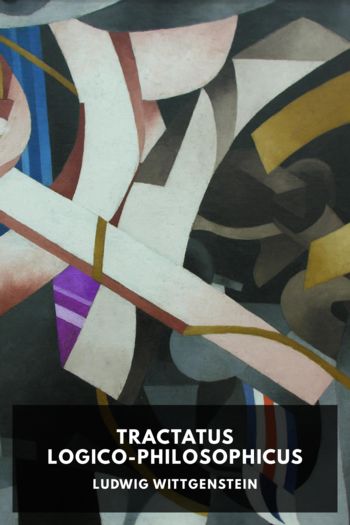Tractatus Logico-Philosophicus - Ludwig Wittgenstein (top 10 ebook reader TXT) 📗

- Author: Ludwig Wittgenstein
Book online «Tractatus Logico-Philosophicus - Ludwig Wittgenstein (top 10 ebook reader TXT) 📗». Author Ludwig Wittgenstein
(If b stands in one of these relations to a, I call b a successor of a.)
4.126In the sense in which we speak of formal properties we can now speak also of formal concepts.
(I introduce this expression in order to make clear the confusion of formal concepts with proper concepts which runs through the whole of the old logic.)
That anything falls under a formal concept as an object belonging to it, cannot be expressed by a proposition. But it is shown in the symbol for the object itself. (The name shows that it signifies an object, the numerical sign that it signifies a number, etc.)
Formal concepts, cannot, like proper concepts, be presented by a function.
For their characteristics, the formal properties, are not expressed by the functions.
The expression of a formal property is a feature of certain symbols.
The sign that signifies the characteristics of a formal concept is, therefore, a characteristic feature of all symbols, whose meanings fall under the concept.
The expression of the formal concept is therefore a propositional variable in which only this characteristic feature is constant.
4.127The propositional variable signifies the formal concept, and its values signify the objects which fall under this concept.
4.1271Every variable is the sign of a formal concept.
For every variable presents a constant form, which all its values possess, and which can be conceived as a formal property of these values.
4.1272So the variable name “x” is the proper sign of the pseudo-concept object.
Wherever the word “object” (“thing,” “entity,” etc.) is rightly used, it is expressed in logical symbolism by the variable name.
For example in the proposition “there are two objects which …”, by “(∃x,y) …”.
Wherever it is used otherwise, i.e. as a proper concept word, there arise senseless pseudo-propositions.
So one cannot, e.g. say “There are objects” as one says “There are books.” Nor “There are 100 objects” or “There are ℵ0 objects.”
And it is senseless to speak of the number of all objects.
The same holds of the words “Complex,” “Fact,” “Function,” “Number,” etc.
They all signify formal concepts and are presented in logical symbolism by variables, not by functions or classes (as Frege and Russell thought).
Expressions like “1 is a number,” “there is only one number nought,” and all like them are senseless.
(It is as senseless to say, “there is only one 1” as it would be to say: 2+2 is at 3 o’clock equal to 4.)
4.12721The formal concept is already given with an object, which falls under it. One cannot, therefore, introduce both, the objects which fall under a formal concept and the formal concept itself, as primitive ideas. One cannot, therefore, e.g. introduce (as Russell does) the concept of function and also special functions as primitive ideas; or the concept of number and definite numbers.
4.1273If we want to express in logical symbolism the general proposition “b is a successor of a” we need for this an expression for the general term of the formal series: aRb, (∃x):aRx.xRb, (∃x,y):aRx.xRy.yRb. …
The general term of a formal series can only be expressed by a variable, for the concept symbolized by “term of this formal series” is a formal concept. (This Frege and Russell overlooked; the way in which they express general propositions like the above is, therefore, false; it contains a vicious circle.)
We can determine the general term of the formal series by giving its first term and the general form of the operation, which generates the following term out of the preceding proposition.
4.1274The question about the existence of a formal concept is senseless. For no proposition can answer such a question.
(For example, one cannot ask: “Are there unanalysable subject-predicate propositions?”)
4.128The logical forms are anumerical.
Therefore there are in logic no preeminent numbers, and therefore there is no philosophical monism or dualism, etc.
4.2The sense of a proposition is its agreement and disagreement with the possibilities of the existence and nonexistence of the atomic facts.
4.21The simplest proposition, the elementary proposition, asserts the existence of an atomic fact.
4.211It is a sign of an elementary proposition, that no elementary proposition can contradict it.
4.22The elementary proposition consists of names. It is a connection, a concatenation, of names.
4.221It is obvious that in the analysis of propositions we must come to elementary propositions, which consist of names in immediate combination.
The question arises here, how the propositional connection comes to be.
4.2211Even if the world is infinitely complex, so that every fact consists of an infinite number of atomic facts and every atomic fact is composed of an infinite number of objects, even then there must be objects and atomic facts.
4.23The name occurs in the proposition only in the context of the elementary proposition.
4.24The names are the simple symbols, I indicate them by single letters (x, y, z).
The elementary proposition I write as function of the names, in the form “fx”, “φ(x,y)”, etc.
Or I indicate it by the letters p, q, r.
4.241If I use two signs with one and the same meaning, I express this by putting between them the sign “=”.
“a=b” means then, that the sign “a” is replaceable by the sign “b”.
(If I introduce by an equation a new sign “b”, by determining that it shall replace a previously known sign “a”, I write the equation—definition—(like Russell) in the form “a=b Def.”. A definition is a symbolic rule.)
4.242Expressions of the form “a=b” are therefore only expedients in presentation: They assert nothing about the meaning of the signs “a” and “b”.
4.243Can we understand two names without knowing whether they signify the same thing or two different things? Can we understand





Comments (0)